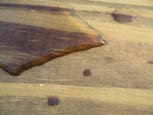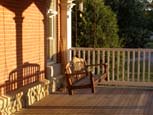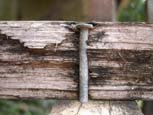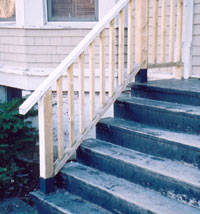PROTECT YOUR DECK:
NOTE: The following info was originally published by: decksgo.com
For many areas warm weather only lasts for about six months of the year. Which means during the other six months your deck is facing the harsh elements that come with the climatic changes from summer to winter.
That also means in order to preserve your wooden deck you will have to maintain it each year in some way.
Depending on your climatic conditions, the causes of deterioration may vary but generally fall within the following sources. Be sure to focus your annual deck maintenance strategy accordingly.
CAUSES OF DETERIORATION ON DECKS

The most common source of deterioration of decks is water. Moisture causes the wood to expand and when it dries out it contracts.
This can cause fasteners to pop and boards to warp, crack and split. If the deck remains constantly wet, a perfect environment exists for fungus and bacteria to establish itself and that is when rot begins. In a worst case scenario, wet rot will result in wood members turning to mush over time.
Preventing this can be as simple as sweeping your deck regularly, clearing away puddles, dirt and leaves that retain moisture and don’t dry out easily.

Sun is also a cause of deterioration to decks. Ultra violet rays can break down the bonds between wood cells.
Fortunately, sun damage isn’t as serious as water damage because the rays only penetrate about 1/100th of an inch into the wood, really only affecting the surface.
The interesting thing is that this damaged surface actually protects the healthy wood below and if you sand it away the fresh wood exposed will become damaged. So, the best deck maintenance for a wood deck in a sunny area is a good coat of sealant or stain.
Insects can also cause serious damage to decks depending on your area.
Cedar and redwood are insect resistant but not insect proof. There is a difference. The best material for decking that is near soil and therefore insects is pressure and marine treated lumber.
INSPECT YOUR DECK

At the beginning of each season be sure to conduct a thorough inspection of your deck.
Annual deck maintenance checks include walking around the deck to listen for squeaks. Try to feel soft spots or sagging areas.
Take a screw driver and use it to physically pick or apply pressure to key components of the deck. Wood gets soft as it begins to rot and poking boards with a screw driver will reveal these tell-tale signs.
Check all areas where there is direct wood to wood contact. We have mentioned this in other articles but its even more relevant when it comes to doing the annual check up.
EXAMINE WHERE DECK BOARDS CONTACT JOISTS
Check where joists contact beams and where the beams contact posts.
Annual deck maintenance isn’t complete without examining the posts and concrete footing contact points as these areas are particularly prone to moisture.
Check the ledger board where the deck connects to the house. Check the bottom of the stair stringers where contact is made with the ground or landing area.
Take note of areas that are showing water stains as these areas are telling you they received constant moisture and have potential for future problems.
If the area is open grain and facing up to the elements, it will suck water in via capillary action very effectively. After all that’s how trees live. But even for any piece of dimensional lumber regardless of whether it is standing vertical or laying flat, the “infrastructure” is still there, so watch out.
These are critical areas to maintain your wooden deck.
REPLACE ROTTING BOARDS

This requires a bit of a surgical approach sometimes as you may have to only remove one rotting board tucked in tightly among other deck boards.
A circular saw and a sharp chisel are required for this kind of work. The saw won’t entirely cut across the decking without damaging the next board.
So, finish the cut with a sharp chisel.
CHECK YOUR STAIRS

Deck stairs tend to be susceptible to rot in a couple of key areas – the stringer tread connection points, and the stringer landing points.
The end grain of the stair treads can soak up water in a hurry depending on how you have configured the tread stringer connection.
The stringer itself is also susceptible to rot at the foot where it contacts the landing and the end grain is very vulnerable to soaking up water like a straw.
Proper deck maintenance involves checking the health of the stringers and elevating them somewhat off the landing.
DO A BIT AT A TIME OR A LOT ALL AT ONCE
Annual deck maintenance should be an annual routine. It will help you keep on top of things and then you will never have to do a major overhaul.
If you incorporate annual deck maintenance into your routine you’ll spend just a little extra time each spring or fall maintaining it and more time enjoying it!
USGS Waterway Monitoring Center (Real Time Water Conditions): CLICK HERE
FEMA Flood Preparedness Info: CLICK HERE
American Red Cross Flood Info: CLICK HERE
Below are system manuals for HVAC and water heater units as well as links to helpful maintenance info and trade referrals.
LENNOX HVAC MANUALS:
Lennox_XC21(Ver.04-current)
Lennox_XP16_Manual
NAVIEN WATER HEATER MANUAL:
Navien-Owners-Manual
LINKS TO MAINTENANCE INFO/CALENDARS:
-Embed Maintenance Reminders in Your Google Calendar: Click Here
-General Maintenance Advice (By System): Click Here
-General Home Maintenance Manual/Check List: Click Here
-Life Expectancy of Home Systems: Click Here
MAINTENANCE LIST:
For a bullet list of maintenance recommendations CLICK HERE
REFERRAL INFO:
Trade referrals can be viewed HERE
Where Is All This Smoke Coming From?
There are a number of factors that can contribute to smoke and draft problems in the home. The most common contributors are related to inadequate air flow. When your chimney’s air flow is restricted, smoke will not be able to properly and completely exit through the chimney system. As a result, you may have a backflow of smoke into your home and air supply. Smoke can stain your furniture and walls and can be extremely harmful to your health. There are a number of things that can affect the air flow in your chimney system including flue obstructions, creosote buildup, a closed or damaged damper, improper sizing of the fireplace, poor design, the airtightness of your home, and competing appliances.
- Flue Obstructions – If your chimney lacks a cap and crown, or if either of these is deteriorating, animals and environmental debris can gain access to your chimney system. Oftentimes, animals will nest inside of a chimney because it seems like a warm, safe, and sturdy place to raise a family. Not only does this nesting create smoke problems and inefficiency problems, it is also a fire hazard. Without a professional inspection, it is nearly impossible to know if your flue has an obstruction of any kind.
- Creosote Buildup – Creosote is a natural byproduct of wood-burning, and typically settles on the interior surface of the chimney. Overtime, this accumulation thickens and can greatly reduce air flow within the chimney. Creosote is also a highly-flammable material and should be regularly removed for your safety and the safety of your home.
- A Closed or Improperly-Functioning Damper – Sometimes the cause of smoke problems is a simple one such as a closed or broken damper. A damper acts as a door between your home and your chimney opening and is used to control the amount of air flowing into your fireplace. If your damper is closed or damaged when you use your fireplace, smoke will be trapped and forced to come back into your home.
- Improper Sizing Of The Fireplace/Poor Design – If your fireplace was not designed with the size of your flue in mind, you may experience problems with smoke in your home. When your fireplace is too big for the flue, it takes in more air than the flue can expel. As a result, excess smoke will not be able to make it out of the chimney fast enough and will seep back into your home or settle as creosote.
- Air-Tight Homes – Most modern homes are built airtight for efficiency, which can deprive the chimney of the air that it needs to properly flush smoke out. In homes where this is the cause of smoke problems, an outdoor air source can be installed into the fireplace to help feed air into the home.
- Competing Appliances – Sometimes, your chimney may be starved of air because it is competing with a fan elsewhere in the house. This can trap smoke and even draw it back into the home. You may want to try turning off all bathroom and kitchen fans and dryers while utilizing your fireplace.
What Are You Burning?
Another factor to consider when dealing with a smoke problem is the type of wood you’re burning. If you are burning wood with a high moisture content, the excess moisture will take on the form of excess smoke.
Click HERE for additional information on asbestos products in older buildings.
